|
no. 3 july - september 2004
Carmel of the Sacred Heart of Jesus in Beja Celebrates 50 th AnniversaryOn Sunday, April 25, 2004, the Carmel of the Sacred Heart of Jesus in Beja, Portugal, celebrated 50 years of existence. The actual date of the anniversary is April 22. A solemn Mass of Thanksgiving with Carmelite Bishop Antonio Vitalino Dantas presiding. Concelebrating were Henrique Martins, the Carmelite Superior in Portugal, the Vicar General of the Diocese, Antonio Domingos Pereria, the confessor of the community, Afonso Prata, the monastery’s chaplain, Manuel Alves, the Rector of the seminary, Manuel do Rosario, and other priests of the diocese. The chapel of the Carmel was full of the nuns’ family members and by other friends from various parts of Portugal who wanted to give thanks to God and manifest their friendship and dedication to the nuns. "The celebration of 50 years in Carmel was beautiful," wrote Bishop Vitalino to the nuns shortly after the anniversary. "May all be for the glory of God and for our holiest Mother and for the good of all," prayed the nuns. th Anniversary of the Foundation of Carmelite Nuns of Tàrrega (Lleida), Spain On June 6, 2004 the Monastery of Divino Amor of the Carmelite nuns of Tàrrega celebrated 50 years since their foundation. The monastery was founded in 1954 by Carmelites from Vilafranca del Penedès and Barcelona. The nuns look after the religious services of the diocesan sanctuary of Our Lady of Fatima, where the monastery is located. Among the activities scheduled was a conference on June 4, 2004 on "The Interior and Pastoral Life" by Benedictine sister Monserrat Salvat. On June 6, 2004, Bishop Jaime Traserra, Bishop of Solsona, presided at the anniversary liturgy. 75 Years of Service at Mt. Carmel Memorial Mt. Carmel Home – Keens Memorial began when Francis G. Keens, a pioneer Kearney, Nebraska (USA) business man visited the area for the annual inspection of his property, "The Keens Flats." He realized that families were not moving into his apartment building. The majority of the apartments remained unoccupied. The local Church gave the approval to the Corpus Christi Carmelites to assist Mr. Keens by converting the apartment building into a suitable home for the elderly. Extensive renovations were done to convert these flats into nursery facilities and a convent for the sisters. Mt. Carmel Home-Keens Memorial has expanded to become a 75 bed skilled nursing facility, serving the local residents by providing a Catholic home for the seniors and others who need special medical care. The 75 th anniversary celebration took place on April 18, 2004. The day began with Holy Mass during which thanks was given to God for 75 years of service in Kearney, Nebraska.Thanks to all the employees, voluntary workers, friends and benefactors. Thanks to all the elderly persons who choose and will choose to be cared for at Mt. Carmel Home-Keens Memorial.
Pope John Paul II has named Fr. Albert Brincat, O. Carm., as the sede vacante "Apostolic Administrator" of the Diocese of Tarija in Bolivia. Fr. Brincat is a member of the Maltese Province and a long time missionary in South America. Until the naming of a new pastor, Fr. Brincat will enjoy all of the faculties and rights that apply to the diocesan administrator following the norms of canon law and also has full ordinary authority to exercise the pastoral and administrative functions in the Diocese of Tarija. The Pope accepted the resignation of Bishop Adhemar Esquivel Kohenque from pastoral leadership of the diocese on June 2, 2004.
Twenty-one of the Superiors General of the Congregations and Institutes affiliated to the Order, their assistants, and the Prior General, Joseph Chalmers, met at the Carmelite Conference Center in Sassone, Italy. The meeting, which ran from May 14-19, discussed a number of the projects of the Carmelite Family and topics of mutual interest. Carlos Mesters, General Councilor for Latin America, lead a discussion on "The Challenges for the Carmelite Family in the World Today." Carlos assisted the group in developing a framework from which our response can come. An entire day was spent discussing the Carmelite NGO, a project which was introduced at the last gathering of the Superiors General in 2000. Ursula Diasselliss, O. Carm., Superior General of the Congregation of Our Lady of Mount Carmel, and William J. Harry, O. Carm., of the General Council, led the group through a Power Point presentation. They explained the two types of non-governmental organizations recognized by the United Nations and the role of the Carmelite NGO in service to the Carmelite Family’s justice and peace initiatives around the world. The leaders of the various congregations then had the opportunity to explain some of their initiatives. The final part of the day was spent strategizing the next steps to further develop the Carmelite NGO.
Four such meetings have been held since 1989, the last in 2000. Because the commission appointed in 2000 to coordinate the next meeting was unable to carry on, this meeting was coordinated by Rafael Leiva Sanchez, the General Delegate to the Sisters. Its efficient organization allowed everyone to arrive and enjoy a few days of discussion, relaxation, and good food. Assembly of the Union of Superiors General I participated in the Assembly of the International Union of Superiors General (UISG) in Rome, Italy which took place May 9-13. It was a very rich experience with 800 women religious from many different nations and cultures participating. There was generally a good dynamic and organization taking place. The overall theme was "Reconciliation." The methodology used for the meeting was "To See, To Judge, To Do" (Ver, Juzgar, y Actuar). The three experiences of reconciliation also occurred from three different perspectives: world, church, and congregational. To judge was highlighted in a conference entitled "Messengers of Reconciliation in Our World." There were also times for personal reflection, examination of the reality of our situations, dialogue in linguistic groups, reporting of these discussions and discernment in the assembly. A statement by the members of the Union was developed and approved. This will be posted on the internet. Hna. Encarnación Flórez in Modern Art On June the 20, 2004 the Carmel Marienthal (Germany) held the opening day of an exhibition on lectio divina. For many generations art has found a home in Marienthal. A long tradition, reaching back to medieval times, left its traces on this place which was founded in the 13th century as the first Augustinian hermit settlement on German soil. In Marienthal, the visitor not only experiences sacred art from those medieval times but also from important artists who took part in the awakening of modern arts in sacred spaces in the first half of the 20th century. This heritage lives on in the cooperation between the Carmelites and the local organization for arts and history. The latest exibition, the third, gives regional artists the chance to show their works in the old cloister of the monastery. This year, several artists reflected on the topic of lectio divina. Their contributions refer to the individual steps in the lectio approach to scripture: lectio, meditatio, oratio and contemplatio. The art varies from paintings and sculptures to applied designs. The monastery’s cloister proves to be an appropriate environment in which to feature these creative presentations. The cloister signifies the connection between the individual cell of the monk and the church as a space for the community. The visitor feels the same tension in the works of the artists—the passage from individuality to community, based on the steps of lectio divina.
Art is not only to be understood as something that serves or decorates. Rather, it resembles the searching journey of people in this world. It tends to cross borders and limitations. Moments of contemplating the world of art puts people into contact with the spiritual sources of their spiritual life. It also gives one the notion of being a transcendent creature – the goal/aim of the journey is to be found in God. Finally all the different ways of reading the world as a text are tending to meet in the all embracing pretext and context – we call this final text God, the God of all contemplation. Working together – Bridging the gap The poverty in East Timor is never far from the surface. Malnutrition is widespread and disease prevalent. In East Timor the wet season has arrived but has only relieved the food scarcity in a small way. The long dry season left one in six people on the verge of starvation. More than 150,000 people are still experiencing a food crisis. Two years without rain has devastated crops across the country, leaving tens of thousands of people with little option but to forage for wild plants just to stay alive. Many families are reduced to one small meal a day, being either rice, cassava or wild plants, as most of the corn harvest failed due to erratic rains and strong winds. All of these foods are high in carbohydrates but lack protein received from meat and dairy foods. Many families have had to sell their cattle to buy supplies of their staple diet ‘rice’. The rice will feed them for an extended time and if they have enough money, they can buy fruit and vegetables. Many people, including children, therefore only have rice to eat and nothing else. Forty-one percent of the population of East Timor live below the poverty line. Preventable diseases, like tuberculosis, malaria, fungal and bacterial infections are very common. These diseases are often precipitated by malnutrition and continue claiming the health and lives of many East Timorese people.
One of the East Timorese sisters that I spoke to was shocked at the severity of some of the children’s diseases and wounds. The Carmelite sisters have a strong focus in working with women and children and are very much respected by the East Timorese people. The sisters always seem to have big smiles that brighten up the people’s lives and help them to feel safe and secure. The people of Zumalai and neighbouring villages are very grateful to their supporters who have helped the mobile clinic to become a reality. Donations have helped to purchase the medical supplies needed and bring essential medical assistance to the remote villages where the need is the greatest. The service provided by the clinic is helping to address the health problems the East Timorese face on a daily basis. The East Timorese people also thank the Carmelite friars who provide
many services to the Zumalai area. by Rosemary Patterson |
|
RETURN TO THE INDEX FOR 2004 | RETURN TO THE INDEX FOR THIS ISSUE INDEX OF CARMELITE
WEBSITES |

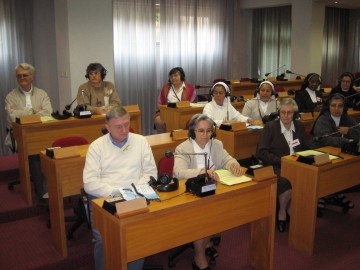
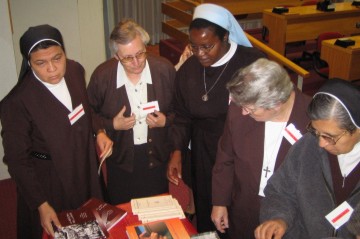 Patrick McMahon, O. Carm., preside of the Institutum Carmelitanum
in Rome, addressed the assembly on the work of the Instititum and
the need for the entire Carmelite Family to become involved in the study
and promotion of our charism, our spirituality, and our history. William
Harry spoke in his capacity as General Councilor for Communications and
Culture in the Order explaining the various initiatives that are underway
in this area.
Patrick McMahon, O. Carm., preside of the Institutum Carmelitanum
in Rome, addressed the assembly on the work of the Instititum and
the need for the entire Carmelite Family to become involved in the study
and promotion of our charism, our spirituality, and our history. William
Harry spoke in his capacity as General Councilor for Communications and
Culture in the Order explaining the various initiatives that are underway
in this area.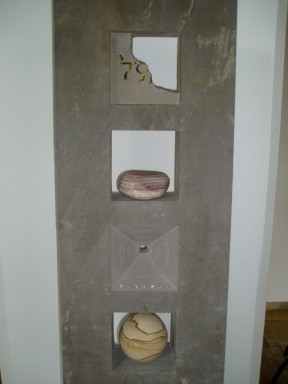
 In an introductory lecture during the opening celebration, Br. Andreas
H. Scholten, O. Carm., spoke about the possibility as well as the
limitations of reading the world’s reality. His explanations conveyed a
broader understanding of lectio divina with a perspective on the
presented pieces of art. He pointed out the connection between how monks
read the Scriptures and the creative way modern artists approach reality.
He explained the open and dynamic way found both in lectio divina
and performance of art that engages the visitor in this very same
movement.
In an introductory lecture during the opening celebration, Br. Andreas
H. Scholten, O. Carm., spoke about the possibility as well as the
limitations of reading the world’s reality. His explanations conveyed a
broader understanding of lectio divina with a perspective on the
presented pieces of art. He pointed out the connection between how monks
read the Scriptures and the creative way modern artists approach reality.
He explained the open and dynamic way found both in lectio divina
and performance of art that engages the visitor in this very same
movement. 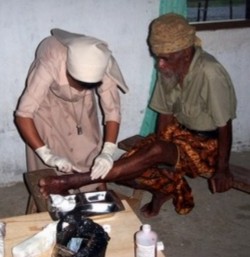
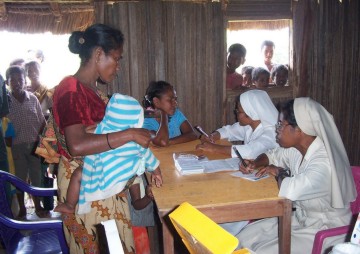 As a way of trying to alleviate some of the widespread health problems
in the remote Carmelite Parish of Zumalai which services 16 small
villages, the Hermanas Carmelitas (Carmelite sisters) who work with the
Carmelite friars have set up mobile health clinics. The sisters are mainly
nurses and their Health Clinic is based in Bobanaro. Together with the
support and help of the friars they travel to the rural and remote areas
of the parish taking medical supplies with them where they see and treat
patients.
As a way of trying to alleviate some of the widespread health problems
in the remote Carmelite Parish of Zumalai which services 16 small
villages, the Hermanas Carmelitas (Carmelite sisters) who work with the
Carmelite friars have set up mobile health clinics. The sisters are mainly
nurses and their Health Clinic is based in Bobanaro. Together with the
support and help of the friars they travel to the rural and remote areas
of the parish taking medical supplies with them where they see and treat
patients.